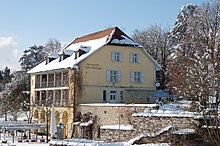House Salmegg
The Salmegg house is a listed former residential building in Rheinfelden (Baden) . It is located directly on the banks of the Rhine at German customs in front of the Old Rhine Bridge . Stylistically, it can be assigned to neoclassicism .
Surname
The name Salmegg is derived from the term "Salm" for the salmon that used to be found in large numbers in the Rhine . On a small foundation in the Rhine, directly in front of the house, there used to be a so-called “Salmenwaage”, a lever frame with which a fishing net can be lowered into the water and pulled up again.
history
Until 1744, when the fort on the "Inseli" in front of Rheinfelden (formerly Stein Castle ) was destroyed, the Gasthaus zur Aue, where court was held, had stood on the site of the current house for several centuries. Directly next to the northern head of the Rhine bridge was (and is still today) a customs post. On the banks of the Rhine below the house there was a boat landing, on the east side of the bridge there was a horse pond (it can still be seen behind today's German customs building).
Today's Salmegg House was built in 1824/25 on the remains of the foundations of the fortifications of the former bridgehead. The builder was Franz Joseph Dietschy (1770–1842). Dietschy, who was born in Wiesental , lived on the other side of the Rhine in Rheinfelden , Switzerland , where he was the owner of the inn and the «Salmen» brewery and city administrator . The Salmegg house was to be a summer house on the sunny side of the Rhine for Dietschy's wife Anna-Maria, née Tschudy. However, she died a few years after it was built. After that, the building was rarely used. Only one of Dietschy's granddaughters, married to the publisher Martin Benziger from Einsiedeln in Central Switzerland, lived there for a long time (until 1911).
The border crossing was closed during the First and Second World Wars. During the time of National Socialism in Germany, when real estate was not wanted by Swiss people in Germany (and vice versa), the descendants had to exchange their property for two houses in Switzerland in 1942, whereby Rheinfelden in Baden came into the possession of the Salmegg family. German families were now forced to live there. At times the city music school was also housed in the house. It was not until 1962 that the large commercial section that was originally in front of the main building was demolished. In 1988 the municipal housing association bought the Salmegg house and the surrounding parkland. The renovation and conversion that took place in 1989 received an award for “good building”.
use
An upscale restaurant is located in the basement of Haus Salmegg and an event hall with a wedding room on the ground floor. On the first floor there are rooms for exhibitions of the Association for Art and History Haus Salmegg and the city museum of Badisch Rheinfelden was located on the top floor until 2017. The landscaped former park of the house is now part of the city park of Badisch Rheinfelden; A memorial in it reminds of Dietschy's deceased wife and old trees (including a large red beech and tall pines) of the former complex.
Works of art at the Salmegg house
On the forecourt between the Rhine bridge and the Salmegg house stands the so-called city column, created by the sculptor Leonhard Eder from Rheinfelden in Baden. It consists of shell limestone , like the subsoil of the Rhine in this region. A pair of oversized hands through which - indicated in stone - water swells, symbolizes the use of the river's water power in the old Rheinfeld hydroelectric power station , which became the nucleus of the Baden city. Chemical formulas engraved on the side of the column refer to the important aluminum and chlorine chemistry in the history of the industrial city. You can also find the names of the city's mayors. Color strips correspond to the city colors.
In front of the terrace of the Salmegg restaurant, on one of several concrete plinths on the German bank of the Rhine, which originally carried masts of a power line from the Rheinfelden hydropower plant to the Augst / Wyhlen power plant , a work of art ("Dickfigur Beteigeuze ") by the Swiss artist Bernhard Luginbühl has been standing since 1997 . The iron ball, which weighs over a ton and has an anchor on chains, is a gift from the Swiss Rheinfelden to its sister city in Baden on the occasion of the 75th anniversary of the town's elevation.
In the Rhine, directly in front of the Salmegg house, there is a deep depression in the river bed, the infamous St. Anna Loch because of its dangerous eddies . In a free artistic interpretation of a mythical story about this Sankt-Anna-Loch, the artist Roland Kistner, who lives in the nearby Höllhaken-Haus on the German bank of the Rhine, designed a fountain with two on the restaurant terrace of the Salmegg house on the occasion of the 2007 garden show in Rheinfelden in Baden Bronze figures: an amphibious female figure (with gills and large frogs' feet, over which water flows into a small stone basin) sits on a stone structure on the bank parapet; the figure mourns a drowned child lying next to it.
Web links
Coordinates: 47 ° 33 '21.4 " N , 7 ° 47' 17.3" E


